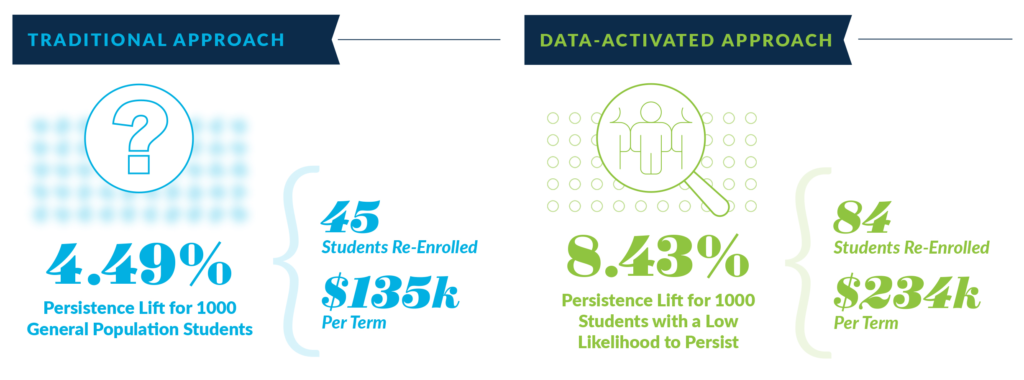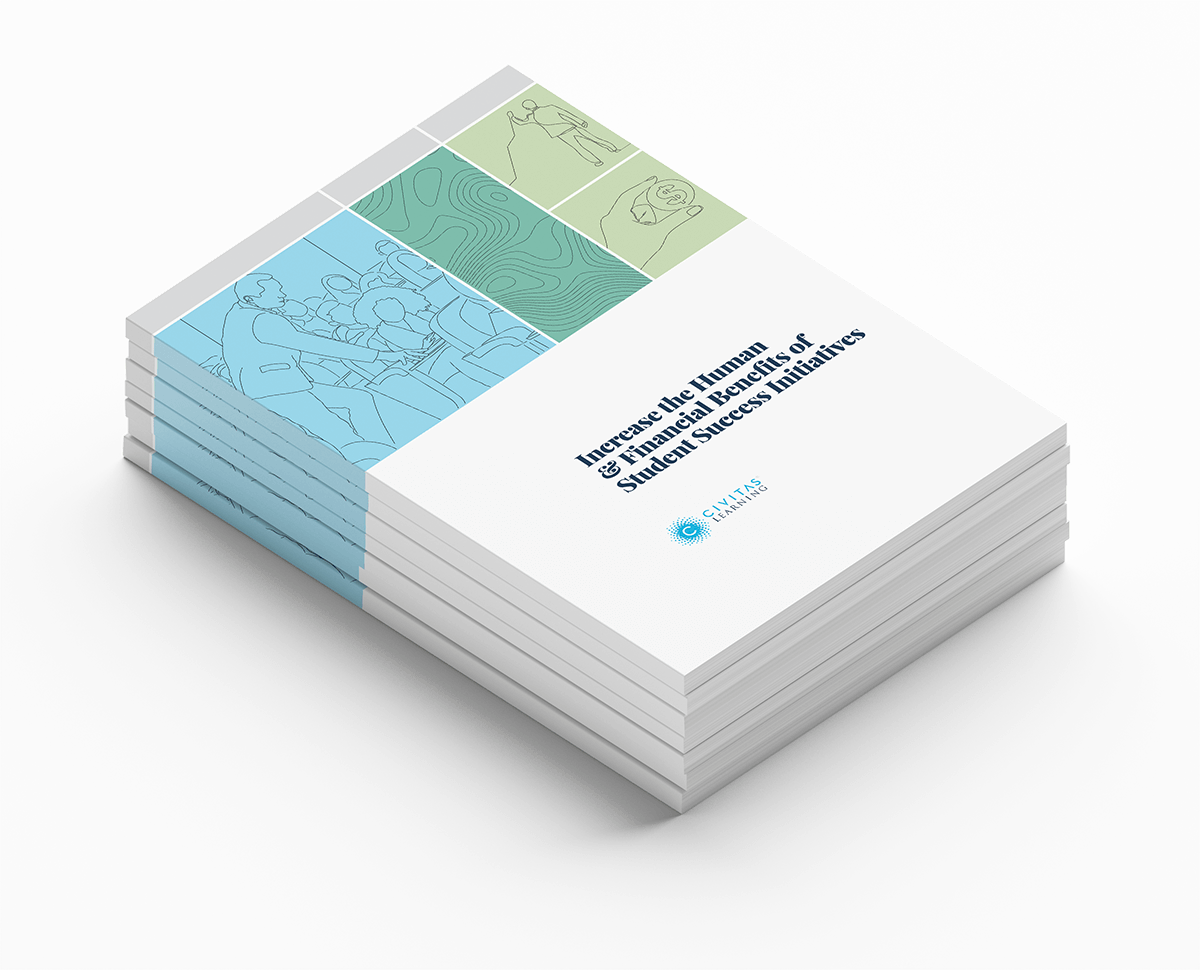
Reveal Hidden Retention Strategies with Segmented Student Data
Share this Post
While the historic decline in enrollment is a big challenge for higher education, it’s also an opportunity. This decline in new students gives institutions a chance to take a closer look at ways to improve the retention of continuing students.
Every student’s path to graduation is unique. But specific student sub-groups experience similar challenges that consistently impact their success. Transfer students, first-generation college students, and part-time students working full-time jobs face challenges beyond academic ability. For example, recommending tutoring to a student whose academic performance is affected by their duties as a single parent fails to address the root cause of the student’s issues and shows a lack of understanding of their whole experience.
To provide effective student support, institutions must develop a more holistic understanding of the challenges that impact student outcomes. Leaders and success teams can uncover unique factors that impact their students and learn which student success initiatives best support them by disaggregating student data to monitor the progress of specific student groups.
Empowered with actionable analytics, our partner institutions can easily segment student data to:
- Offer more precise personalized support,
- Scale proactive engagement, and
- Understand the impact of student success initiatives on specific student groups
Moving from generalized knowledge to a precise understanding of student data leads to positive student outcomes, eases staff capacity constraints, and improves institutional financial health through the persistence of existing students.
Maximizing the Impact of Student Success Practices

1. Offer Precise and Personalized Support
High-impact student success initiatives have even greater potential when institutions can match the right support strategy to the unique needs of specific student groups. Segmenting data ensures that students receive the support they need to address their challenges.
At Snow College, administrators discovered that students in the lower quartiles of predicted success benefit more from personalized advising than students in the higher quartiles using Civitas Learning’s initiative analysis capabilities.
This insight prompted the Snow Academic Advising Center to experiment with group advising for students with a higher likelihood of persistence to increase capacity for individual advising meetings and to personalize outreach to students in the lower quartiles. Knowing which students benefit most from one-on-one advising allows Snow’s advisors to modify their advising practices to more precisely meet the needs of all students.
Instead of focusing on average outcomes, campus leaders need a nuanced understanding of barriers to success. They must also know which support strategies are most impactful for specific student groups—investing in a solution that enables teams to gain student-specific insights results in more personalized support and a better student experience.
When students feel that the institution they attend understands them and needs support, they are more likely to persist and reach their educational goals.
2. Scale Proactive Student Engagement
Advisors know that one-size-fits-all practices do little to support the students in greatest need. But, with average advising caseloads of 350 students or more, advisors still struggle to provide proactive, personalized support. Students most likely to use advising services are often better prepared for college and usually in less need of personalized help. These students keep advisors’ calendars full, especially around peak advising times, limiting advisors’ capacity to serve the most vulnerable students.
A data-informed approach to student outreach helps advisors move beyond one-size-fits-all service driven by the registration cycle. Instead, insight into current student needs empowers advisors to connect with students who need the most support while there is still time to make a difference. Access to real-time persistence and completion predictions allows teams to offer more efficient and precise support at scale.
Northeastern State University created a pilot program utilizing the Civitas Learning persistence prediction to identify and actively monitor students in the lowest quartiles of predicted success. Updated throughout the semester with behavioral and academic data, the persistence prediction provides just-in-time information about which students may be struggling and in need of extra support.
Segmenting their advising caseloads enables them to identify potentially at-risk student groups. NSU advisors could more actively monitor changes to the persistence predictions for that group. This practice allows advisors to conduct proactive outreach when a student’s persistence prediction changes, making it possible for advisors to be there for students when they need additional support. The pilot program resulted in 35 more students continuing their college experience –a 1.7% lift in persistence translating into an $80,804 gain in net tuition revenue.
Administrators and student success teams face increasing pressure to help students stay on track. Large caseloads and limited insights about which students need support make it difficult to achieve desired student outcomes. Institutions and students alike benefit when advisors can segment their advising caseloads to focus on the needs of specific student groups.
Segmenting student data enables teams to serve their entire caseload while monitoring and proactively reaching out to students who need their support the most. Making it easier for advisors to identify and support at-risk students eases capacity constraints and helps institutions scale proactive, personalized support.
3. Understand the Impact of Success Initiatives on Specific Student Groups
Campus leaders must understand which success initiatives are working to allocate limited resources to the most effective programs. Leaders can make more strategic decisions when equipped with the ability to examine the impact of programs, policies, and initiatives on specific segments of the student population.
A public university in Florida uses initiative analytics capabilities to measure the impact of engagement in campus life activities on student persistence. Through their analysis, they learned that student engagement of any kind significantly impacts overall persistence but has the most significant impact on students who are least likely to persist. Some forms of engagement, such as health-related workshops and Campus Recreation involvement, resulted in a 7–8% lift in persistence among the bottom quartile students.
These insights enabled the student success team to connect students to relevant involvement opportunities proactively. This strategy and other data-informed practices contributed to more than doubling its four-year graduation rate, with the most significant gains recorded among black, Latino, and Pell-eligible students.
Knowing the impact of student success initiatives on specific student groups reveals new opportunities to help students and renews institutional support for existing programs already working to support student success. Evaluating practices based on their impact on specific student groups leads to more precision in an institution’s efforts to help all students on their path to success.
Improving Student Success Through Segmentation of Data Supports Students and Institutions
If there is a silver lining to the complex challenge of declining enrollment, campus leaders must become more knowledgeable about the needs and challenges students face. Doing so will improve the student experience and drive the re-enrollment of continuing students.
Institutions that segment student data to develop a greater understanding of the characteristics and needs of specific student populations can offer more precise and proactive support and better evaluate student success initiatives to determine which strategies provide the best return on investment.
Segmenting student data leads to improved student outcomes, which, in turn, bolsters institutional sustainability and success for future generations of students.



